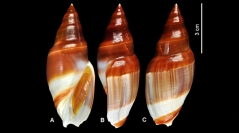

 European Journal of Taxonomy
2020 (706) - Pages 1-59
European Journal of Taxonomy
2020 (706) - Pages 1-59In the ancillariid genus Amalda, the shell is character rich and 96 described species are currently treated as valid. Based on shell morphology, several subspecies have been recognized within Amalda hilgendorfi, with a combined range extending at depths of 150–750 m from Japan to the South-West Pacific. A molecular analysis of 78 specimens from throughout this range shows both a weak geographical structuring and evidence of gene flow at the regional scale. We conclude that recognition of subspecies (richeri Kilburn & Bouchet, 1988, herlaari van Pel, 1989, and vezzaroi Cossignani, 2015) within A. hilgendorfi is not justified. By contrast, hilgendorfi-like specimens from the Mozambique Channel and New Caledonia are molecularly segregated, and so are here described as new, as Amalda miriky sp. nov. and A. cacao sp. nov., respectively. The New Caledonia Amalda montrouzieri complex is shown to include at least three molecularly separable species, including A. allaryi and A. alabaster sp. nov. Molecular data also confirm the validity of the New Caledonia endemics Amalda aureomarginata, A. fuscolingua, A. bellonarum, and A. coriolis. The existence of narrow range endemics suggests that the species limits of Amalda with broad distributions, extending, e.g., from Japan to Taiwan (A. hinomotoensis) or even Indonesia, the Strait of Malacca, Vietnam and the China Sea (A. mamillata) should be taken with caution.
Amalda hilgendorfi species complex, deep-water Amalda, Cox1, integrative taxonomy